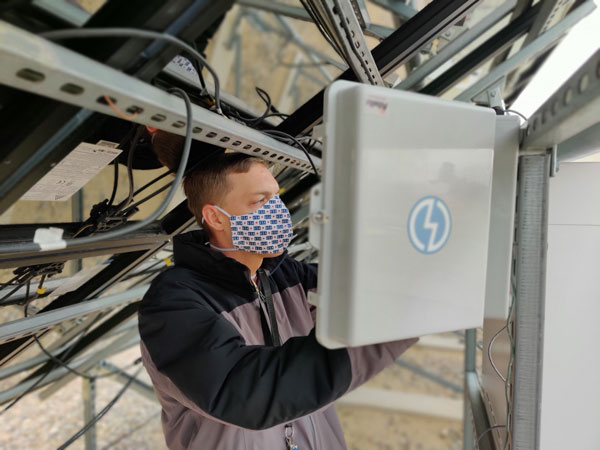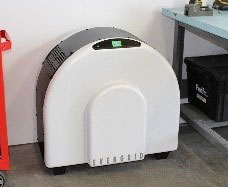DOE’s Solar Energy Technologies Office recently announced round three winners of its American-Made Solar Prize, both Sandia partners through the competition’s voucher program.
“This is great news from a Sandia perspective,” said Laurie Burnham, Labs photovoltaics researcher. “We supported one of the two grand prize winners in rounds one and two and took the podium in round three.” Since the competition began in 2018, Sandia has supported 15 companies, including eight semi-finalists and four of the six winners.
Small businesses with solar prize vouchers have made Sandia a favorite because it offers expertise and technical capabilities to support small companies who wouldn’t otherwise have access to high-precision facilities and renowned experts, Laurie said.
“The vouchers can be used at any national lab, and these companies have chosen Sandia, which offers capabilities in a number of fields, such as materials sciences, cybersecurity, forensics, diagnostics, and others,” she said.
In fact, a number of Sandia departments and scientists rallied to help make connections and support both round three winning projects:
Wattch — photovoltaic system monitoring device

“Wattch is the Fitbit for PV systems monitoring,” Laurie said. “All large-scale PV systems are monitored to some degree, and real-time system performance enables operators to monitor the health of their systems and know if they are performing as expected.”
Laurie said, “Wattch is differentiated by its predicative capability, and is meant to be relatively inexpensive, portable and a widely deployed device —much like a Fitbit.”
Solar researcher Dan Riley, supporting principal investigator to round three winner Wattch, said even though a company’s technology or product may focus on the solar sector, the development process is typically multifaceted.
“Sandia’s really deep, broad expertise in many different fields allowed Wattch to go forward with its round three submission,” Dan said. “For instance, the Wattch product must be securely connected to the internet, so we were able to connect the company with Lon Dawson’s energy security group. It’s the breadth of scientific inquiry we have at Sandia that allows these companies to put forth compelling proposals.”
Funding from the American-Made Solar Prize is allowing Sandia to test the Wattch device in Albuquerque and at the Nevada and Florida Regional Test Centers for Emerging Solar Technologies. Sandia researchers compare the quality of the Wattch device with Sandia’s high-fidelity data systems to confirm that Wattch is picking up all of the necessary data and processing it within an acceptable accuracy range.
Sandia also helps with vulnerability testing to ensure the device can be securely integrated into a photovoltaic system tied to the grid. The Sandia team is helping select appropriate models and designing the analysis software for the project.
Maxout Renewables — Evergrid for backup power

Maxout Renewables Evergrid came into existence in the aftermath of the disastrous California Camp Fire of 2018, when downed transmission lines were blamed for starting one of the most deadly and costly wildfires in California history.
After that fire, during similar environmental conditions, California utility companies implemented a preemptive power outage or Public Safety Power Shutdown as a preventive measure.
The owners of Maxout Renewables wondered how to keep electricity flowing from photovoltaic systems even when the utilities turned the power off, thereby isolating those systems from the grid.
The Evergrid product solves this challenge by acting as a stand-alone appliance that provides affordable, safe backup power when the grid is down.
Sigifredo Gonzalez, a renewable energy researcher, was principal investigator on the Evergrid project, which combines a small battery pack device that provides the signal for the PV inverters to come online and spin up a flywheel.
The Evergrid system enables the PV system to restart and operate autonomously from the utility, Gonzalez said. The inexpensive, flywheel-based unit is more affordable than a battery backup system and can reduce the size of traditional battery backup systems.
“The cybersecurity, Environmental Safety and Health and distributed energy groups all assisted Maxout Evergrid, so the technology can be made to operate when the utility experiences outages caused by environmental conditions or equipment failure,” Gonzalez said.
“The American-Made Solar Prize program is a great method to incite innovation and is beneficial to Sandia because it allows the lab to keep its finger on the pulse of innovation that’s being developed,” he said. “Some technology may never progress, but other intellectual property will go all the way to commercialization.”
Sandia helps technology grow
Using Sandia’s expertise to assist a small business in the growth of its technology, while at the same time exposing researchers to the latest technological innovations, requires a trusted partnership, said Irene Trujillo, who co-leads the Sandia Solar Prize initiative with Laurie. It’s those special connections across the lab that have attracted so many start-ups to Sandia, a virtual one-stop shop for technical expertise across a multitude of disciplines, Irene said.
Anthony Martino, photovoltaics manager, said, “Sandia owes its Solar Prize success not only to all of our technical capabilities, commitment to innovation and can-do attitude, but also to the hard work of Irene Trujillo and Laurie Burnham, who co-lead the program at Sandia and have done a terrific job recruiting companies and pairing them with the right technical teams.”
“The chance to work with the experts at Sandia was an incredible opportunity for our team.”
Both winning companies say they have been pleased with their experiences working with Sandia.
Alex Nussey, chief economic officer of Wattch, said, “The chance to work with the experts at Sandia was an incredible opportunity for our team. We were able to get quick answers to critical questions, and our ongoing experiments will continue to enable a far better product.”
Eric Cummings, co-owner of Maxout Renewables, said his company also had a positive experience.
“We first spoke with Sigifredo Gonzalez early in the project, long before we had proven the concept. His enthusiasm for the Evergrid idea helped us through the usual hiccups and problems of early-stage development.
“As a startup working outside our core technical competence, Maxout benefitted greatly from the institutional knowledge and long-term experience of Sandia and Sigifredo,” he said.
Other Sandia-supported grand prize winners include SolarFlex, a company that has developed a novel design for high-efficiency, low-cost back-contact solar cells; and Solar Inventions, which has created a sub-cell architecture to reduce resistive losses and manufacturing costs.
More information is available about the American-Made Solar Prize.